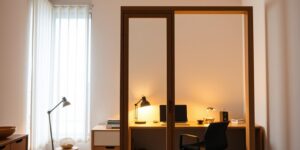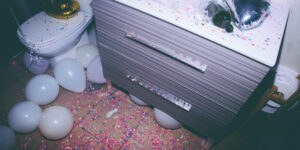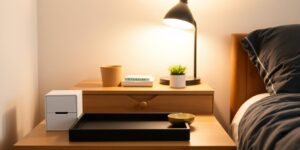5 ways to make your dorm cozier without spending much
Discover 5 simple ways to make your dorm cozier without breaking the bank. Get cozy dorm room ideas to enhance your living space.
Starting college often means adjusting to unfamiliar surroundings. Many students face sterile, impersonal dorm rooms that lack warmth. Turning this temporary space into a welcoming retreat can ease the stress of academic life and help you feel grounded.
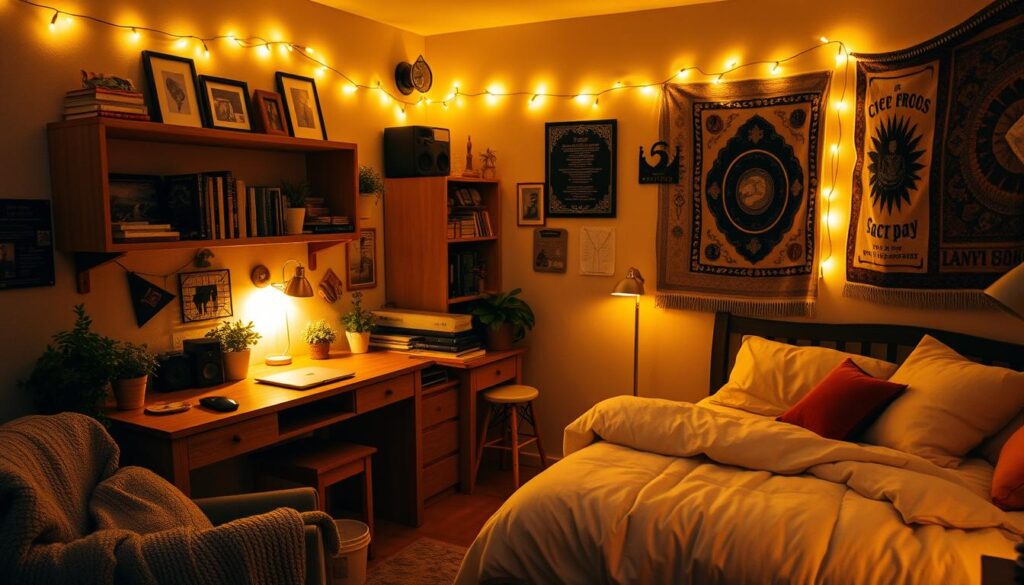
Creating a comfortable environment doesn’t require expensive renovations or designer furniture. Simple changes like layered lighting or textured fabrics add personality without breaking the bank. These tweaks bridge the gap between institutional practicality and the comfort of home.
Personalizing your room also supports mental well-being. Studies show organized, inviting spaces improve focus and reduce anxiety. Small efforts to enhance your surroundings can make a big difference in your daily college experience.
Key Takeaways
- Comfortable living spaces improve academic performance and emotional well-being
- Budget-friendly solutions exist for common dorm room challenges
- Personal touches help combat feelings of homesickness
- Multipurpose items maximize limited space effectively
- Lighting adjustments create instant warmth and ambiance
Introduction
Stepping into a dorm for the first time can stir both excitement and anxiety. Many students grapple with unfamiliar surroundings while balancing academic pressures and newfound independence. The initial weeks often reveal how stark institutional spaces differ from personalized living areas.
Feeling disconnected from familiar environments is common during this transition. A 2022 UCLA study found 68% of first-year students experience moderate to severe homesickness. Creating a welcoming space becomes vital for emotional stability and academic focus.
Simple, affordable changes bridge the gap between sterile setups and areas that feel like home. Textured throw blankets or framed photos inject personality without overspending. These modifications help establish ownership over temporary living quarters.
What Else Would You Like to Know?
Choose below:
Colleges increasingly recognize the link between student well-being and their environments. Small investments in comfort yield significant returns in confidence and community-building. The following strategies demonstrate how thoughtful touches transform basic rooms into functional sanctuaries.
Personalize Your Dorm Space
Transforming institutional spaces into welcoming areas starts with personal expression. Visual elements like photographs and artwork turn blank walls into meaningful displays that reflect individuality.
Display Photos and Artwork
Printed pictures of family, friends, or pets add instant familiarity. Use damage-free adhesives like Blu-Tack to arrange them creatively:
- Cluster small frames near study areas
- Create timelines with chronological snapshots
- Mix landscapes with portrait shots for visual variety
String lights with mini clips allow easy photo rotation. Bulletin boards work well for ticket stubs or postcards alongside images. Choose posters that showcase hobbies or inspirational quotes to reinforce personal identity.
DIY Personal Touches
Handmade elements elevate standard dorm furniture. Try these budget-friendly ideas:
- Paint thrift-store frames in school colors
- Arrange pressed flowers in dollar-store shadow boxes
- Stencil motivational words above your bed
Check housing rules about walls before hanging items. For strict policies, lean framed art on desks or use removable washi tape borders. These adaptations maintain room character while respecting shared spaces.
Affordable Bedding and Comfort Upgrades
Institutional bedding often falls short in providing restful sleep. Upgrading these essentials transforms basic setups into personal sanctuaries that support both relaxation and productivity.
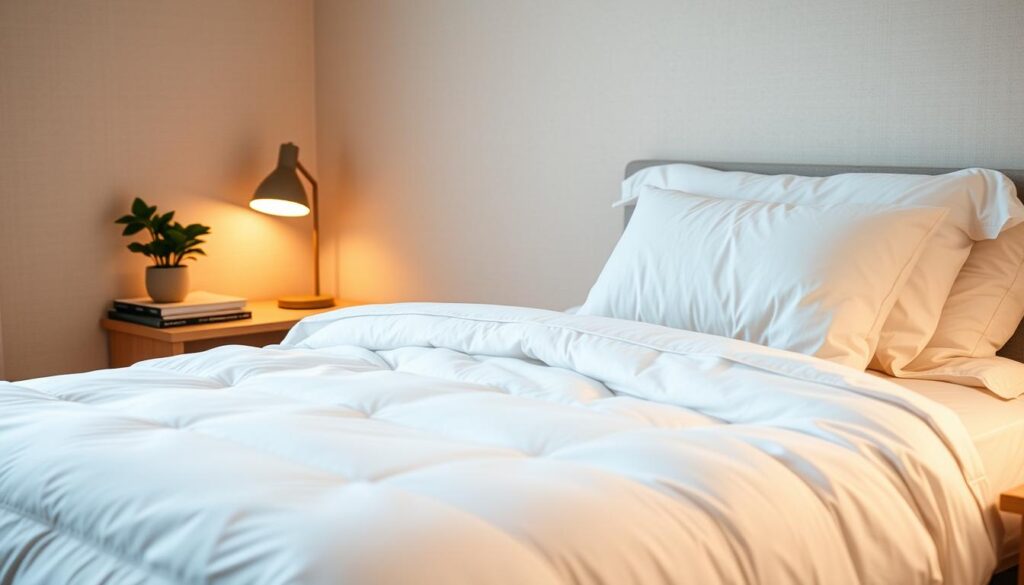
Swap Scratchy Bedding for Cozy Comfort
Standard-issue sheets frequently use rough polyester blends. Replace them with breathable cotton or microfiber options from discount retailers. Many stores offer twin XL sizes specifically designed for campus beds at under $20 per set.
Prioritize bedding that feels familiar. Bring a favorite blanket from home if possible, or choose new patterns reflecting your style. Soft textures signal safety to the brain, easing stress during demanding study sessions.
Enhance Your Sleep with Pillows and Blankets
Layered pillows create visual depth while improving neck support. Combine firm base cushions with softer decorative ones. Fleece throws add warmth during late-night study marathons without overwhelming small spaces.
Consider these fabric characteristics for easy care:
- Machine-washable covers withstand shared laundry cycles
- Hypoallergenic fills reduce allergy risks
- Quick-dry materials prevent mildew in tight quarters
A well-curated bed becomes more than a sleeping area—it serves as a daytime reading nook and impromptu guest seat. This multifunctional approach maximizes limited square footage while boosting emotional well-being.
Enhance Lighting for a Warm Atmosphere
Harsh fluorescent fixtures often drain comfort from institutional spaces. Layered illumination transforms cold rooms into inviting areas while supporting daily routines. Combining multiple light sources reduces reliance on overhead glare and creates visual depth.
Using Fairy Lights for a Soft Glow
Battery-operated fairy lights provide dorm-safe solutions. String them along bed frames or drape over mirrors using damage-free adhesive hooks. Their warm glow mimics sunset tones, which psychologists associate with relaxation and stress reduction.
Complement these with adjustable desk lamps featuring LED bulbs. Choose models with three color temperatures to match activities—bright white for studying, soft yellow for unwinding. This adaptability helps maintain natural sleep cycles despite late-night study sessions.
For shared spaces, try these placement strategies:
- Cluster lights around headboards for reading nooks
- Line shelving edges with LED strips
- Use floor lamps to define seating areas
Affordable options from brands like Brightech or TaoTronics comply with campus safety rules. Proper lighting layers balance functionality and ambiance, turning basic rooms into adaptable sanctuaries.
Clever Storage and Organization Ideas
Smart organization transforms cramped quarters into functional living areas. Limited square footage demands creative solutions that balance accessibility with visual calmness. Strategic storage systems reduce clutter-related stress while preserving precious floor space.
Under-Bed Storage Solutions
The average twin XL bed offers 14 inches of vertical clearance—enough for rolling plastic bins or vacuum-sealed clothing bags. Measure your bed frame before selecting containers to ensure smooth sliding. Clear bins let you spot items quickly, while wheeled drawers simplify seasonal rotations.
| Storage Type | Best For | Price Range |
|---|---|---|
| Flat under-bed boxes | Bulky sweaters | $8-$15 |
| Stackable drawers | School supplies | $12-$25 |
| Vacuum bags | Seasonal clothes | $10-$20 |
Creative Shelving Options
Wall-mounted shelves turn blank surfaces into display zones. Floating units from IKEA’s EKBY series hold textbooks while leaving desk space free. Over-door organizers with pockets store shoes or toiletries without drilling.
“Clutter directly impacts cognitive function,” notes professional organizer Lisa Jacobs. “Designated storage zones help students maintain focus during exams.”
Modular cube shelves adapt to changing needs—use some cubes for folded jeans, others for snack stashes. Pair with decorative baskets from Target to hide less attractive essentials. This approach keeps daily items within reach while maintaining a tidy appearance.
Incorporate Greenery for a Fresh Vibe
Living plants transform institutional environments into vibrant spaces. They filter airborne toxins while adding natural texture to rigid layouts. Even small specimens create focal points that soften angular furniture and plain walls.
Low-Effort Botanical Companions
These resilient varieties thrive in campus living conditions:
| Plant Type | Care Requirements | Light Needs |
|---|---|---|
| Succulents | Water every 2-3 weeks | Direct sunlight |
| Air plants | Mist twice weekly | Indirect light |
| Pothos | Water when soil dries | Low to moderate |
| Spider plants | Weekly watering | Filtered light |
NASA research shows certain plants remove 87% of indoor pollutants within 24 hours. Snake plants work overnight, making them ideal for stuffy study areas. Group 3-4 varieties together for maximum air purification.
Dorm-friendly displays require minimal effort:
- Use mason jars as terrariums for succulents
- Hang air plants in geometric wire holders
- Train pothos vines along curtain rods
“Caring for living things reduces cortisol levels by 28%,” states behavioral researcher Dr. Ellen Torres. “Even brief plant interactions lower academic stress.”
Check campus rules about greenery in shared spaces. Many schools prohibit soil-based plants but allow hydroponic systems. For tight budgets, swap cuttings with classmates or browse Walmart’s $5 indoor plant section.
Creative Decor on a Budget
Blank walls in dorm rooms often feel impersonal and uninspiring. Strategic decorative choices can inject personality while respecting strict housing guidelines. Textured fabrics and removable installations offer temporary solutions that leave no trace at move-out.
Inexpensive Wall Art and Tapestries
Lightweight curtains or woven tapestries soften angular spaces better than posters. These fabric pieces absorb sound and add depth to flat surfaces. Command Hooks work well for hanging without damaging paint—check your dorm’s specific rules before installing.
Consider these damage-free display options:
- Removable wallpaper strips as accent borders
- Framed postcards arranged in geometric patterns
- Fabric swatches stretched over foam boards
Thrift stores often carry vintage scarves that double as wall hangings. For custom style, iron printable fabric sheets with personal photos. This approach creates gallery-like displays at a fraction of framing costs.
| Decor Type | Cost Range | Installation Time |
|---|---|---|
| Removable decals | $5-$15 | 10 minutes |
| Fabric tapestries | $12-$30 | 5 minutes |
| Framed prints | $8-$25 | 15 minutes |
Group smaller pieces to form visual clusters near study areas. This technique defines zones in multi-use spaces while maintaining a cohesive feel. Always consult residential advisors about approved hanging methods—some buildings prohibit even painter’s tape.
Make Your Dorm Cozier
Cold floors and unfamiliar surroundings can challenge student well-being. Area rugs soften hard surfaces while adding visual warmth. Choose low-pile options for easy cleaning—ideal for high-traffic dorm rooms.
These textile additions define functional zones in open layouts. Place a 5×7 rug between beds to create a shared lounge area. Layer smaller mats near desks for foot comfort during study sessions.
| Rug Type | Best For | Price Range |
|---|---|---|
| Memory foam bath mat | Bedside comfort | $12-$18 |
| Indoor/outdoor carpet | High spill areas | $25-$40 |
| Faux sheepskin | Reading nooks | $15-$28 |
Personal items bridge the gap between campus life and home routines. A cherished mug or worn-in slippers provide tactile familiarity. These objects activate sensory memories that feel like emotional anchors during stressful weeks.
Prioritize multipurpose comforts when packing:
- Travel throws that double as decorative accents
- Compact heating pads for chilly evenings
- Reusable tumblers with inspirational quotes
Combining practical textiles with meaningful mementos cultivates environments that support academic focus. This layered approach turns sterile rooms into spaces that dorm feel intentionally curated rather than temporarily occupied.
Maximizing Comfort with Affordable Furniture
University life demands quality rest, but standard dorm mattresses rarely deliver. Strategic upgrades bridge the gap between institutional basics and comfort that feels like home. Focus on pieces serving multiple purposes to optimize limited space.
Cost-Effective Mattress Toppers and Futons
A quality mattress topper transforms rock-hard dorm beds. Memory foam options contour to body shape, while down-alternative versions provide plush softness. Organic cotton blends offer breathability for warmer climates.
| Material | Benefits | Price Range |
|---|---|---|
| Memory Foam | Pressure relief | $40-$80 |
| Latex | Eco-friendly | $60-$120 |
| Wool Blend | Temperature control | $55-$95 |
Futons maximize functionality in tight quarters. The Organic Cotton & Wool model folds from seating to guest bedding in seconds. Its natural fibers resist odors—ideal for shared spaces.
- Choose machine-washable covers for easy maintenance
- Measure room dimensions before purchasing
- Look for non-slip bottoms on seat cushions
Place floor cushions near low windows to create reading nooks. These budget-friendly adjustments help spaces evolve with changing needs throughout the academic year.
Designing a Functional Study Area
Academic success thrives in spaces designed for concentration. Separating study zones from relaxation areas trains the brain to associate specific spots with productivity. This mental division helps maintain energy levels during late-night sessions.
Designated Study Corners
Carve out a corner exclusively for academic work. A compact desk paired with an ergonomic chair creates physical boundaries in shared rooms. Position this area away from beds to strengthen focus through environmental cues.
Vertical storage maximizes limited square footage. Install floating shelves above the workspace for textbooks. Use wall-mounted file holders for quick access to syllabi and notebooks.
Efficient Desk Organization
A clutter-free desk surface enhances cognitive performance. Try these space-saving solutions:
- Magnetic strips for holding paper clips and thumbtacks
- Stackable drawer units for school supplies
- Cable organizers to prevent cord tangles
Task lighting proves essential for reducing eye strain. Choose adjustable LED lamps with color temperature settings. Cool white light (5000K) mimics daylight for optimal alertness during study time.
FAQ
How can I add personal touches without damaging dorm walls?
What are affordable bedding options for small budgets?
Are fairy lights allowed in most dorms?
Which plants thrive in low-light dorm rooms?
How do I maximize storage in a tiny dorm?
What’s a cost-effective way to upgrade a dorm mattress?
How can I create a functional study area in my room?
How to Decorate a Studio Apartment for Under $100: Student-Friendly Hacks
» See exclusive tips for your home




